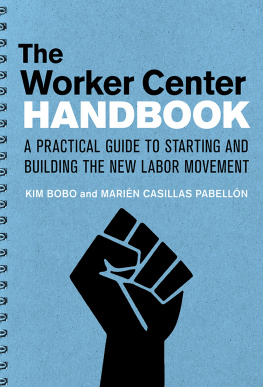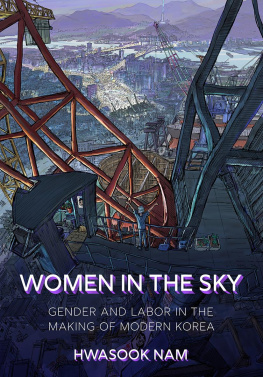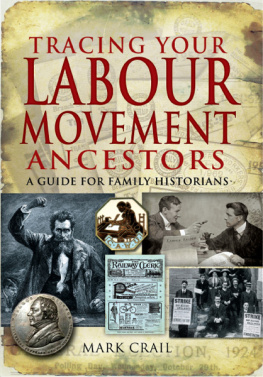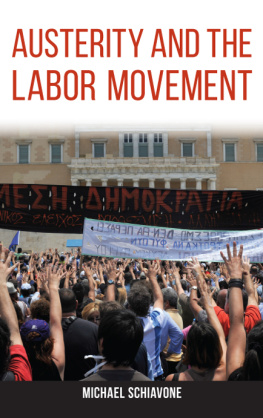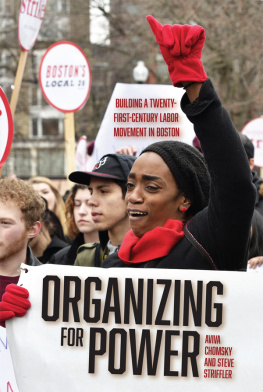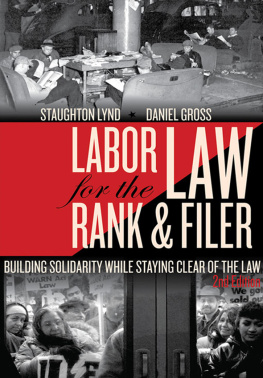Acknowledgments
T his book is the product of the worker center movement. We have both had the privilege of walking with, observing, and learning from worker centers in the Interfaith Worker Justice network for many years. Marin also had the privilege of serving in a member organization of the National Day Laborer Organizing Network. We are both huge fans of all the leaders and staff of all the worker centers in the nation that are truly doing the work of God on earthbringing justice and righteousness to workers.
We are also grateful to Interfaith Worker Justice for giving us the time and support to work on this book. Sarah Cho, a wonderful work-study student, helped us compile the appendices.
We sought the input of lots of our colleagues in the work. Many graciously gave of their time to read the documents, ask thoughtful questions, and add suggestions they thought might help others.
Heroic thanks go to those who read and commented in great detail on every chapter: Jules Bernstein, Leone Bicchieri, Aina Gutierrez, Patrick Hickey, Anne Janks, Jose Oliva, and Hilary Stern.
We are grateful to those who read the entire manuscript and offered general advice on tone and direction or corrected sections relating to their work, and those who gave detailed input or feedback on a particular chapter or a few chapters: Gustavo Andrade, Deborah Axt, Adam DeRose, Marcela Diaz, Neidi Dominquez, Janice Fine, Marcy Gelb, Brian Glick, Jennifer Gordon, Jaribu Hill, Cathy Junia, Adam Kader, Esther Lpez, Rudy Lpez, Julian Medrano, Pete Meyers, Celeste Monforton, Lisa Moore, Christine Neumann-Ortiz, Mary Ochs, Hunter Ogletree, Brian Payne, Laura Perez-Boston, Wade Rathke, Misty Rebik, Angelica Salas, Sarah Shikes, Marilyn Sneiderman, Mayumi Swanson, Emily Timm, Jack Willey, Chris Williams, and Allison Zidek.
Adelante! (Forward in the struggle for justice!)
K IM AND M ARIN
| Worker Center Background and Vision

Figure 1 New Labor members and allies march in support of Domestic Workers Bill of Rights. Photo Courtesy of New Labor. Photo by Louis Kimmel.
D omestic workers organize support for a statewide bill of rights. Restaurant workers rally outside a restaurant demanding that the owner pay them their stolen wages. Poultry workers expose dangerous chemicals used in their plant and bring in government inspectors. Day laborers organize themselves to move from an outside corner where they bid against one another for jobs to a safe location with clear policies for workers to get jobs and be paid fairly. Immigrant women challenge designer-brand labels that produce clothes in modern-day sweatshops. African American workers battle the exclusionary practices of temp agencies. Dairy workers gather at night to learn their rights. Tomato pickers establish new codes of conduct in the fields. Workers, through worker centers, are organizing for themselves and their communities.
Workers have always organized. From the Israelites in Egypt who organized a strike (Exodus 5) to the Southern Tenant Farmers Union in the South and the mass organizing of northern workers in the 1930s, farmworker organizing in the 1960s, and the current worker organizing today. Organizing is part of the human spirit that seeks to be treated with justice and fairness.
Through organizing, leaders emerge and develop. Structures are put in place to train leaders, recruit members, and make decisions. Organizing campaigns to change particular workplaces, entire sectors, or public policies for all workers demonstrate and build power for workers.
Workers and their allies who are leading, growing, and developing the current worker center movement are following in the footsteps of labor and community organizers who went before them. Although the worker center movement appears new and in some ways is indeed creating some new structures and models, it is built on the shoulders of previous generations of organizers, both in the United States and elsewhere.
Cesar Chavez organized farmworker service centers in the 1960s that modeled the importance of integrating services and organizing. Worker centers build on that history.
Paulo Freire, a Brazilian professor and educator, developed models for popular education that inspire worker centers today.
Martin Luther King, Jr., Dorothy Day, and Gustavo Gutirrez, who supported poor workers and organized faith communities in the U.S. South, northern cities, and Peru, inspire worker centers to build faith partnerships and tap the moral imagination of the nation.
Courageous union organizers, like those at Teamsters Local 688 in St. Louis and Local 22 of the Food, Tobacco, Agricultural and Allied Workers in Winston-Salem, North Carolina, built models of community unionism that united workers and allies across racial lines to fight racial capitalism. Todays worker centers and their union allies strive to build organizations and movements that understand how capitalism uses race to exploit and divide workers and that address challenges workers face in their workplaces and their communities.
Organizing is part of the U.S. tradition. Organizing is part of the global tradition. Organizing is inherent in being human. Worker centers build on those traditions and bring to life a new incarnation of the human spirit.
Crisis for Workers
Millions of U.S. workers are struggling to make ends meet. Ten million workers dont earn enough to reach the official poverty line. Millions more are one or two paychecks away from homelessness. Approximately 10 percent of workers earn $8.50 an hour or less and 42 percent earn less than $15 an hour. Those earning the lowest wages seldom have benefits. Among that bottom 10 percent of wage earners, 88 percent have no employer-provided health insurance, and 88 percent have no employer-provided retirement savings. New contingency structures of work are creating low-wage permatemps and so-called independent contractors, denying workers living wages and stable jobs. Millions of these workers, as well as additional middle-class workers, are victims of wage theft when their employers illegally underpay them or dont pay them for their work. Thousands are needlessly injured on the job because their employers dont provide adequate safety protection.
This crisis for workers has many causes, which is partly why worker centers operate on many fronts. The poverty wages and poor working conditions for many workers are caused in large part due to the lack of power workers have in society, particularly in relation to their employers. Historically the most importance counterbalancing power for workers has been unions. When unions represented approximately a third of workers, as they did until the mid-1970s, they were able to set standards in many sectors, even if all workers werent members, and successfully advocate worker protections nationwide. Unions now represent less than 10 percent of workers and arent structured to support workers in a wide variety of small companies. Worker centers organize workers because there arent enough unions organizing workers.
The crisis is caused by weak labor standards, for one thing. The United States has some of the weakest labor standards in the industrialized world. It has no federal standard for paid sick days, vacation days, maternity leave, or universal health care. Some basic standards, like workers compensation to care for injured workers, are left to the states, resulting in a mishmash of programs or no programs. In addition, what labor standards exist are generally not well enforced, despite the best intentions of many dedicated enforcement staff. Federal and state labor agencies are woefully understaffed. Worker centers organize to establish new labor standards and increase enforcement.


